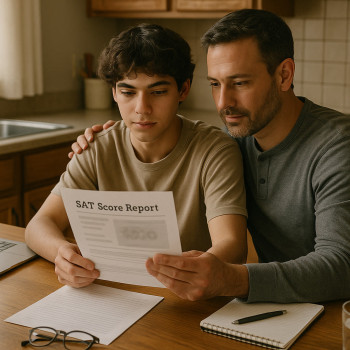Why this matters: the Digital SAT is different — and practice matters more than ever
If your child is preparing for the Digital SAT, you’re not alone in feeling both excited and a little overwhelmed. The test still measures the same core skills — reading, writing, and math — but the delivery, tools, and practice experience have changed. That makes practice tests not just helpful, but essential. Practicing under digital conditions gives students fluency with the interface, timing, and the adaptive behavior of the test. For parents, understanding what to expect can turn worry into a concrete plan that helps your student walk into test day calm, confident, and ready.

Top things parents need to understand about Digital SAT practice tests
1. The test is adaptive — practice must reflect that
Unlike the old paper SAT or even a linear online test, the modern Digital SAT adapts. That means sections or question sets adjust based on a student’s performance. When practice tests are taken in the same app used for the real exam, students experience that adaptive behavior. Practicing the digital format helps students get comfortable with the pacing and the feeling of moving through question sets that respond to their answers. It also gives realistic score feedback tied to the digital scoring model.
2. Bluebook practice tests are the real deal — encourage your child to use them
The official testing app provides full-length practice tests that mimic the real testing environment. Students should take at least one full-length adaptive practice test in the Bluebook app before test day, both to learn how the interface works and to see how time feels when sections adapt. If time allows, taking a second practice test closer to the actual test date is another smart move — it helps pinpoint what to review in those final weeks.
3. Tools and features matter — practice on the same device
Bluebook supports certain devices and includes tools like a built-in calculator, highlighting, and navigation features. Practicing on the same device type (or the exact device) your student will use on test day prevents surprises. If your school provides a school-managed Chromebook, or your child will borrow a device, make sure they practice with that setup if possible. Also, check any accessibility features or approved accommodations well in advance and practice with them turned on when applicable.
How parents can turn practice tests into a powerful study strategy
Set a realistic practice schedule
Consistency beats intensity. Break practice into manageable blocks so your student doesn’t burn out. A balanced schedule might include one full-length practice test every 4–6 weeks, shorter focused sessions 2–3 times a week, and targeted review after each practice attempt. The aim is steady improvement — not last-minute cramming.
Use practice tests to diagnose — not just to measure
Practice tests are diagnostic goldmines. After a full-length practice session, sit down with your student and review more than just the score. Look at question types missed, timing patterns, and any test-taking habits (for example, rushing through the first five questions). This is where specific study beats general practice: if the student consistently misses geometry problems, prioritize geometry practice. If they lose time on multi-step evidence-based reading questions, practice pacing strategies for those specific items.
Turn mistakes into a study plan
Keep an errors log. For each missed question, note the content area, the reason for the mistake (conceptual, careless, or timing), and a short plan to fix it. Over time, patterns will emerge and make it easier to create targeted practice sessions. Parents can help by setting small weekly goals based on patterns: two algebra practice sets this week, timed reading passages next week, etc.
Practice the full test experience — including breaks and logistics
On test day, small details matter: setting up the device, connecting headphones (if allowed), managing the test timer, and taking the allotted break. Run a rehearsal: have your student install/launch the Bluebook practice test, complete a timed section, take the scheduled break, and finish the rest. Practicing logistics reduces anxiety and the chance of technical surprises on test day.
What to watch for during practice — practical tips for parents
Timing and pacing
- Track how long your child spends on each question type.
- Teach them to flag questions to return to later rather than getting stuck early in a section.
- Encourage short, focused timing drills for question types that slow them down.
Comfort with the digital interface
- Let them explore Bluebook’s navigation, highlighting, and answer review features during practice.
- Emphasize that some functions are different from paper tests — for example, searching for keywords is different digitally, and on-screen math tools may change how you scratch out work.
Stress and test-day mindset
- Use practice tests to simulate test-day pressure in a controlled way — timed, quiet, and distraction-free.
- Teach simple pre-test routines: a short walk, a healthy breakfast, and a calming breathing exercise.
Accommodations and assistive technology
If your child uses assistive technology or has approved accommodations, practice with those exact settings in Bluebook. That practice ensures the technology works smoothly and your student is comfortable using it during the exam.
How to interpret practice test results: a parent’s quick guide
Practice test scores are a snapshot — useful, but not the whole story. Here’s a quick table to help you and your student interpret results and decide the next steps.
| Practice Result Pattern | What it likely means | Actionable next step |
|---|---|---|
| High score variability between tests | Inconsistent pacing, test fatigue, or unfamiliarity with digital format | Practice full-length tests more regularly; simulate test-day conditions; log time spent per section |
| Consistently weak in one content area | Knowledge gap (e.g., algebra or evidence-based reading) | Targeted content review and practice sets; short daily drills |
| Good content knowledge but low scores | Test-taking strategies or pacing issues | Strategy work: process of elimination, educated guessing, time management |
| Slow but accurate | Strong fundamentals but needs speed | Timed practice, sectional drills, and adaptive practice tests to build pace |
Practical examples and mini-plans for different timelines
Six months to test day (ample time)
- Monthly full-length Bluebook adaptive practice tests (take one every 4–6 weeks).
- Weekly targeted sessions: 2–3 shorter sessions focused on weak areas.
- Monthly review of error logs and a study plan update with parent and student.
Two months to test day (focused sprint)
- Full-length practice test every 2–3 weeks.
- Daily 30–60 minute focused drills (rotating between reading, grammar, and math).
- Simulate test day once a week with full timed sections and breaks.
Two weeks to test day (polish and confidence)
- Take one final full-length digital practice test about 10–14 days out.
- Target a short list of high-yield items to review (formulas, grammar rules, problem types).
- Prioritize rest, routine, and mental prep in the final 48–72 hours.
How parents can support without taking over
Balancing support and independence is tricky. Students need encouragement and structure, but the work has to be theirs. Here are practical ways to help:
- Be the planner: help schedule practice sessions and test-day logistics so the student can focus on the work.
- Be the coach, not the critic: celebrate progress and keep setbacks in perspective.
- Monitor, don’t micromanage: glance at practice score trends and ask reflective questions rather than giving answers.
- Do the life stuff: make sure test-day transportation, meals, and tech setup are taken care of.
When to consider extra help: tutoring, targeted programs, and tech-driven insights
Some students benefit from personalized instruction beyond practice tests. If your student is plateauing, losing confidence, or juggling other obligations, consider targeted tutoring. Personalized tutoring can provide 1-on-1 guidance, customized study plans, and focused strategy work — turning practice-test data into action. Modern tutoring services often combine expert tutors with AI-driven insights to analyze practice-test patterns quickly and recommend precise drills for improvement. If you try tutoring, look for tutors who use official practice materials and incorporate full-length Bluebook practice tests into their plans.
For example, Sparkl’s personalized tutoring blends expert tutors with tailored study plans and AI-driven insights, helping students convert practice-test feedback into measurable progress. When a tutor reviews Bluebook results together with a student, they can design focused sessions that address both content gaps and pacing habits, which is often more efficient than generalized study.
Technical checks and logistics: a parent’s pre-test checklist
- Install and test Bluebook well before test day; verify device compatibility.
- Confirm any accommodations and practice with them enabled.
- Have a backup device plan if possible, or know how to borrow a device through the testing program or school.
- Practice with the exact setup (earbuds/headphones, screen brightness, power plugs) you’ll use on test day.
- Teach your student how to flag and return to questions within the app, and practice that behavior.
Common parent questions — and short answers
How many full-length practice tests should my child take?
At minimum, two: one a few months out and one two weeks before the test. If time allows, add one more early in preparation to benchmark and another mid-cycle — so 3–4 total is a practical target.
Should practice tests be timed exactly like test day?
Yes. Timed practice under realistic conditions is the most valuable. Simulating the quiet, the timer, and the break builds stamina and mental readiness.
Is paper practice still useful?
Paper practice is useful for content review and for students with paper accommodations. But digital practice in Bluebook is non-negotiable for most students because it replicates the adaptive behavior and interface of the real test.
What if my child gets discouraged by practice results?
Turn discouragement into data. Bad practice tests give clear signals about what to work on. Celebrate concrete wins: a pacing improvement, a missed concept fixed, or an error type reduced. If discouragement persists, short-term focused tutoring can rebuild confidence and momentum.
Putting it all together: a sample 8-week sprint plan using practice tests
Below is a straightforward schedule that mixes full-length practice, targeted drills, and rest. Adapt the pace based on your student’s baseline and school commitments.
- Week 1: Baseline — full-length Bluebook practice test; review error log and set 3 focus areas.
- Week 2: Targeted drills — four 45-minute sessions focused on the three areas; light full-section timing practice.
- Week 3: Strategy week — practice test question types and test-taking strategies; one 45-minute full timed section practice.
- Week 4: Full-length adaptive practice test; compare results to Week 1 and adjust focus areas.
- Week 5: Deep content review — targeted practice daily (30–60 minutes); pacing drills on weaker section.
- Week 6: Mixed practice — two shorter practice tests (sections only) and strategy review.
- Week 7: Final full-length practice in Bluebook; run a test-day simulation including logistics and break.
- Week 8: Light review, rest, and confidence-building activities; avoid heavy new content the last 48–72 hours.
Final thoughts — how parents help students get the most from practice tests
Parents play a pivotal role as planners, cheerleaders, and sanity-checkers. Your job isn’t to teach every math concept or proofread every essay — it’s to create the environment where consistent, reflective practice can happen. Make sure your student practices in the same digital environment they’ll use on test day, treats practice tests as diagnostic tools instead of final judgments, and turns errors into action items. When the path forward needs extra structure, consider personalized tutoring that pairs expert guidance with data-driven study plans. With steady, realistic practice, most students make reliable gains — and the result is often less stress and more college-choice confidence.
One last tip: celebrate small wins. A faster pacing habit, one fewer careless errors, or the confidence to return to a flagged question are all progress. The Digital SAT is a different format, yes, but it’s also a new opportunity to prepare smarter — not harder. With the right practice tests, a clear plan, and supportive guidance, your student will be ready for test day.

















No Comments
Leave a comment Cancel